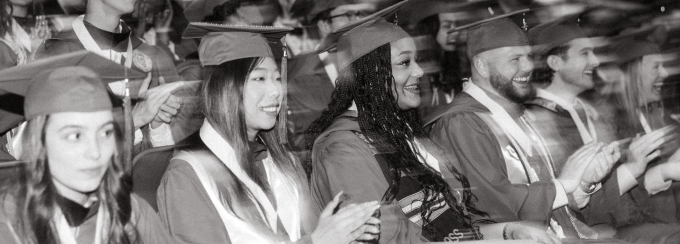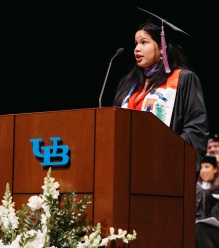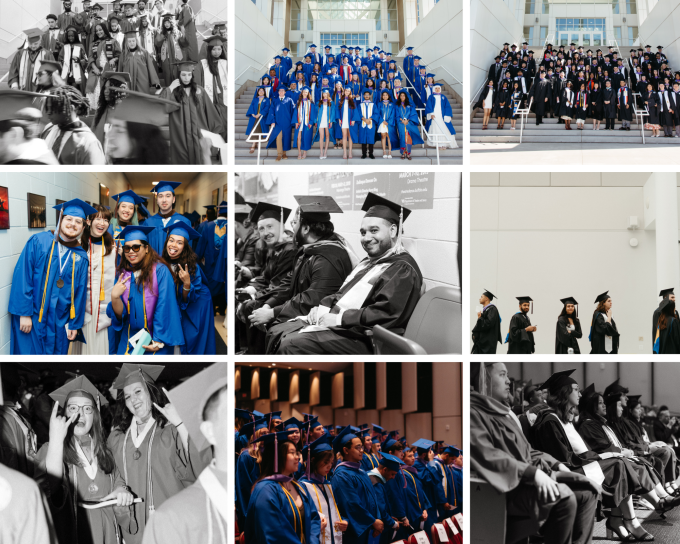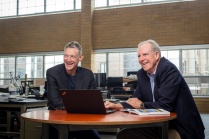Commencement 2025

On May 16, 2025, the School of Architecture and Planning held its 53rd commencement ceremony. Photos by Jackson Zimmerman Photography.
53rd Commencement Ceremony
On May 16, 2025, more than 190 graduates crossed the stage as the 53rd graduating class of the School of Architecture and Planning. Graduates and their families and friends, along with distinguished guests, joined together at UB's Center for the Arts.
View an accessible PDF of the commencement program for the UB School of Architecture & Planning Ceremony, including a listing of all graduates in the Class of 2025.
ON THIS PAGE
Photo Gallery
Photos by Jackson Zimmerman
Keynote Speakers and Dean’s Medal Awardees
James Timberlake (left) and Stephen Kieran (right). Photo by Sahar Coston-Hardy.
Stephen Kieran, FAIA, and James Timberlake, FAIA
Partners, KieranTimberlake
This year, we were honored to present the Dean's Medal, the highest honor bestowed by the School, to Stephen Kieran and James Timberlake, who have made significant contributions to the fields of architecture and planning.
Educated and trained as architects and committed to research-driven practice, Kieran and Timberlake have advanced an approach to design that addresses critical social, environmental, and economic inequities. Their collaborative practice seeks elemental beauty and usefulness through an environmental ethic informed by research, technology, and innovation. Together, they have earned more than 300 design citations, including the AIA Firm Award and the Cooper-Hewitt National Design Award, and have served as visiting professors at leading universities across the country.
University of Buffalo School of Architecture and Planning Class of 2025, Dean Czerniak, esteemed faculty, parents, and honored guests, we are grateful to offer these brief remarks and observations as you embark on your career pursuits. Graduation from a long educational journey is time to stop and reflect - while simultaneously anticipating a future yet to come. We all have come a long way to be a part of this noble profession – in our collective case it is over fifty years since we began our journey as architects. From different paths, places, and backgrounds, we both have forged a friendship and professional partnership which has endured. Our coming together as graduate students at the University of Pennsylvania, to form an internationally renowned firm, is a remarkable analogue to architecture itself. Architecture and planning, the practice of them, are unique opportunities to embrace and forge simultaneous histories, whether in life, work, or in the outcomes of our collective creations. We have shared the highs and lows of practice and the profession, all the while working toward continually improving our aspiration for the profession and its outcomes.
We want to elaborate further, for a moment, on this theme of simultaneous histories and resiliency, as both are necessary to succeed in this profession. We began drawing by hand, and using slide rules – yes, we are that old – and have participated in over the last half century, as history will determine, one of the most profound transitions in any type of profession or work. Much has changed during our time – methods of conceiving work; ways of constructing work; and the paths to practice for a wider, diverse and talented populace. At each moment of change we sought opportunity. We have embraced the change to practice and encouraged the move from the singular intelligence of the ‘starchitect’ to a collaborative world of diverse backgrounds and voices. We have employed the vast technological advancements that have transformed architecture while developing many of our own contributions that have been widely shared with the profession.
Throughout the past 50 years architecture has proven to be transformative and resilient. You may expect during your time in practice, the contributions you make to the profession will enable architecture and planning to lead and innovate improvements to our built environment on this ‘island home’ we call Earth. We have endured many tests over our years, economically, philosophically, and politically among them. You will as well. This moment is an important crossroad in your next journey.
In the spirit of embracing simultaneous histories and resiliency – we believe it fitting to step back in time, to a simpler, but likely equally challenging time in architecture. One hundred seventy-six years ago, in 1849, John Ruskin, who saw architecture not just as a craft, but as a profound expression of the human spirit, wrote The Seven Lamps of Architecture. This was a work he republished 31 years later, thinking that it had lost relevance. Within that reprint he stated: ‘I never intended to republish this book, which has become the most useless I ever wrote; the buildings it describes with so much delight being either knocked down, or scrapped and patched up into smugness, and smoothness more tragic than uttermost ruin.’ We all face that same contemporaneous fate of our own work in this ever consuming and digesting economy, where history seems to be ‘of the past, not the present.’ We all fear losing relevance. History is our ultimate earthly judgement. In 2025, at this moment, we should indeed be turning to history to understand, adjust, and adapt.
Ruskin’s penned principles within The Seven Lamps of Architecture remain ever relevant in this changing profession. The ‘Lamps’ he described were – Sacrifice, Truth, Power, Beauty, Life, Memory, Obedience – these may seem arcane, and perhaps archaic to our modern lives, yet, like all ethics, and principles that we embrace in life, they are an adaptable foundation to modern life. We believe his Seven Lamps can illuminate the path ahead as you build your lives and careers.
Life in 1849, or even 1880, for an architect, was often solitary, if not a bit acetic – yet Ruskin embraced the holistic foundational attributes of architecture. He illustrated The Seven Lamps with etchings of work he thought to be exemplary. His precis was underpinned by previous centuries of architectural thought and theory. The Roman author Vitruvius’ Ten Books of Architecture (De Architectura) had a profound influence on thought and practice, shaping architecture, planning, and the image of the architect. Alberti, and Palladio, during the Renaissance, subsequently interpreted and independently adapted the Vitruvian Triad of (firmitas, utlitas, and venustas) commodity, firmness and delight for contemporary use in their time, which continues to guide us to this present day.
John Ruskin firmly believed art and architecture should have a moral purpose and a deeper meaning beyond pure aesthetics. His ideas were formed during the early years of the industrial revolution in England, which had led to widespread poverty and social inequality. In penning The Seven Lamps of Architecture, Ruskin was influenced by ‘Essays on The Nature and Principles of Taste,’ written by Archibald Alison. Following Alison’s lead, Ruskin believed ‘the glory of architecture could be found in its age and history.’ He was here embracing space, time, and context; more modern theories developed nearly a century later. In reading Ruskin, we might consider yet another example of embracing simultaneous histories – that of a contemporary life in conversation with the past. Ruskin is pondering a profound moment in a time, during the industrial revolution, when everything was rushing to be ‘new, different, or unique,’ not unlike this time of ours.
Returning to the title of Ruskins’ text, the Lamps he refers to are ‘guiding lights’ or ‘inspirations.’ They show the way and illuminate hidden truths. They shed a bright light upon the darkness of an unknown time to come, and by doing so, show a future that is not to be feared, but embraced.
As we now consider, independently, each of the Seven Lamps, we find contemporary meaning in the past which informs our futures:
The Lamp of Sacrifice: Today, you graduate not simply with degrees, but with a dedication to learning, continuous improvement, and the commitment to personal growth. Just as an architect or planner must dedicate their craftsmanship to a greater vision, so too must you dedicate your knowledge learned to the betterment of our communities, country, and the world.
The Lamp of Truth: May you strive for authenticity in your endeavors, embracing honesty in your actions and integrity in your words. Ethics and principles matter. Your accomplishments should be the result of genuine effort, not facades or illusions.
The Lamp of Power: You are not leaving from this University simply with a collection of skills but with the power to help shape our world. Use this power responsibly. Imagine and build environments of positive change. Challenge the status quo and inspire others to reach their full potential, champion meaningful causes, and construct a better future.
The Lamp of Beauty: In every pursuit, let all of you seek to infuse beauty, whether it be in the eloquence of your speech, the creativity of your ideas, or the compassion of your actions. Just as a well-designed landscape, building or city can lift the human spirit, your endeavors can bring grace and joy to the lives of others. May you strive to bring beauty to your lives and profession through creativity, innovation, and an intentional, thoughtful approach to your work.
The Lamp of Life: Remember that your accomplishments are not merely the product of individual efforts, but also the collective spirit of your families, mentors, and peers. Let us honor and respect the people that have helped you reach this moment. Continue to cultivate a spirit of collaboration in your future endeavors. Carry this spirit of working with others and lifelong learning into your next chapter of life.
The Lamp of Memory: As you embark on those new chapters, carry forward the lessons learned, the friendships forged, and the values instilled in us. Remember that your work is a legacy of your generation to subsequent generations. Remember, too, that the work that came before you deserves your appreciation and respect. Let your accomplishments inspire those who will follow you.
And, lastly, The Lamp of Obedience: True innovation often lies in honoring the principles that have stood the test of time. It is an inevitable part of the human spirit to embrace your individuality, yet, let us also acknowledge the importance of ethical conduct and respect for the established norms of your communities, profession and society.
In a moment, you will step out into the world not just as graduates, but as architects and planners of your own destinies. By embracing the principles of these Lamps - sacrifice, truth, power, beauty, life, memory, and obedience - you may build a better world worthy of our collective aspirations; a world of enduring values that reflects the very best of human potential.
Congratulations!!
May your journey ahead be bright and illuminated by the light of these noble aspirations.
Thank you.
Stephen Kieran FAIA and James Timberlake FAIA
16 May 2025
Student Speaker

Nayarit Tineo (MArch '25)
Commencement Student Speaker
A member of the Master of Architecture program Class of 2025, served as Student Speaker, addressing the graduating Class of 2025 and reflecting on her experience at UB’s School of Architecture and Planning. An engaged student, Nayarit is also a Graduate Research Assistant with UB’s Regional Institute, contributing to research and initiatives within the field.
Good afternoon, everyone!
Distinguished faculty, staff, esteemed guests, proud families, and most importantly, the graduating Class of 2025—welcome! My name is Nayarit Tineo, and it is my absolute privilege to stand before you today as we celebrate this milestone and the journey that brought us here.
We live in a world of uncertainty, where challenges arise unexpectedly, and the future remains unwritten. But through it all, we must believe in ourselves. As visionaries, we’ve learned to shape buildings, ideas, communities, and a better tomorrow. One-chapter closes, but another begins, intertwining our past with the future we are about to create.
We are the future architects, planners, designers, and creators. We hold the power to shape skylines, reimagine cities, and refine our built environment. We’ve spent countless hours in studios, modeling, researching, reimagining, studying and revising. And look at us now—we made it!
Some of my favorite memories at UB are those late nights in the studio, bonding over endless cups of coffee, moments of frustration, and celebrating even the smallest victories. These experiences remind me that success isn’t just about the final product—it’s about collaboration, perseverance, and growth. UB has challenged my thinking, pushed my creative boundaries, and taught me resilience in ways I never imagined.
I want to acknowledge the incredible professors and mentors who have guided us. Their wisdom and belief in our potential have made all the difference. To my peers—thank you for the late-night pep talks, for challenging my ideas, and for inspiring me with your talent and dedication. The connections we’ve built here will shape our futures. A mi querida familia y a Diosito, gracias.
Beyond design and planning principles, we’ve learned that failure is not the opposite of success but a crucial step toward it. We’ve learned that showing up, even on our toughest days, is half the battle. We’ve learned that perseverance, passion, and purpose will carry us through any obstacle. These lessons will guide us as we take our next steps.
Among us are future leaders who will challenge norms, bridge gaps, and create spaces that foster connection and innovation. But as we step into the world, we face uncertainty.
The housing crisis persists, urban inequality grows, injustice endures, and climate change threatens the very fabric of our work. But it is precisely in times like these that architects, planners, and designers are called to rise. We are trained to navigate complexity, to problem-solve, to create something out of nothing, and to work in ways that inspire change.
The world is looking to us to be the change we want to see. If our years of study, sleepless nights, and passion-filled projects have taught us anything, it’s that we are ready.
So today is not the end—it is the continuation of our journey. The world needs our creativity, our boldness, and our resilience. Let us go forward, not just as graduates but as visionaries who will redefine what is possible.
To the Class of 2025—congratulations! May you move forward with courage, purpose, and the belief that you have the power to shape the future. Our journey starts now!
Awards
Department of Architecture
Alpha Rho Chi Medal: Terence Huang (BA Arch '25)
ARCC/King Student Medal for Excellence in Architectural and Environmental Research: Ehler Htoo (MArch + MUP '25)
AIA Medal for Academic Excellence: Katie Nelson (MArch '25)
Department of Urban and Regional Planning
MUP Best Professional Project Award: Adam Zineddin (MUP '25)
MUP Best Thesis Award: Ehler Htoo (MArch + MUP '25)
MUP Best Dissertation Award: Fuzhen Yin (PhD '24)
AICP Planning Excellence Award: Omar Timothy Suri (MUP '25)
- #UBClassOf2025
- #UBuffalo
- #UBSAP

